How to Care for Bare Root Trees
- September 18, 2024
- 0 comment
Bare root trees are a cost-effective and eco-friendly option for adding beauty to your landscape. These trees, sold in a dormant state without soil around their roots, have been widely appreciated for their affordability, ease of handling, and high success rate when planted correctly.
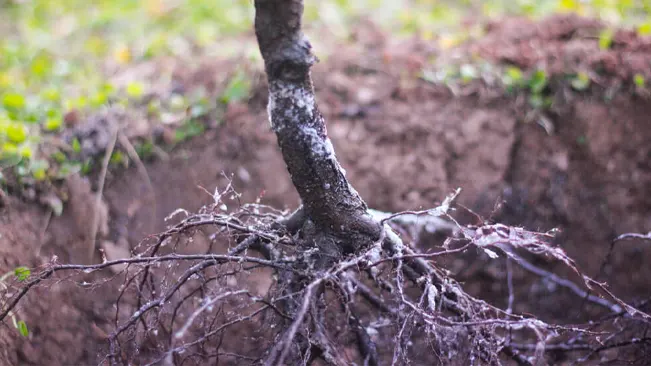
However, bare root trees require a bit more attention during planting and the early stages of establishment than container-grown trees. With proper care, they will grow into strong and healthy additions to your yard or garden. This guide will walk you through the best practices for handling, planting, and nurturing bare root trees to ensure their success.
What Are Bare Root Trees?
Bare root trees are young trees sold with their roots exposed, without any soil or container. They are typically harvested from the ground during the tree’s dormant phase in late fall to early spring, when growth slows down. During this time, the tree is less vulnerable to stress, making it ideal for transportation and planting. Since bare root trees are lighter and more compact than their potted counterparts, they’re easier to ship, which reduces both the environmental impact and the cost of transporting them.
Why Choose Bare Root Trees?
There are several compelling reasons to opt for bare root trees:
- Affordability: Bare root trees are typically more affordable than container-grown trees. Without the need for pots, soil, or extra shipping space, nurseries can offer these trees at a lower cost.
- Environmental Benefits: Since bare root trees are lighter and take up less space, they require fewer resources to transport, which means a smaller carbon footprint.
- Healthier Roots: Bare root trees often have a more extensive root system compared to potted trees, as their roots aren’t constrained by a container. This gives them a better chance to establish themselves quickly after planting.
- Variety: Many nurseries offer a wider selection of tree species in bare root form, providing gardeners with more options to choose from.
However, bare root trees require proper care and handling to ensure they thrive, especially in the initial planting phase.
Steps to Care for Bare Root Trees
1. Preparing for Your Bare Root Tree’s Arrival
The care process begins before you even plant the tree. Once your bare root tree arrives, it’s crucial to plant it as soon as possible, ideally within 24-48 hours. However, if you can’t plant immediately, store the tree properly to prevent the roots from drying out.
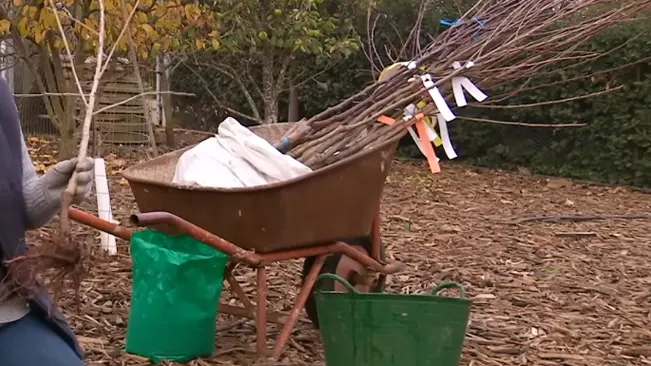
Storage Tips:
- Cool and Damp: Store the tree in a cool, shaded location. Keep the roots moist by wrapping them in damp burlap or newspaper. Avoid leaving the roots exposed to air, as this will cause them to dry out, leading to potential tree failure.
- Temporary Planting: If you cannot plant your tree within a few days, consider “heeling it in.” This involves temporarily planting the tree’s roots in a shallow trench filled with moist soil to keep them hydrated until you’re ready for permanent planting.
2. Soaking the Roots
Before planting, it’s crucial to soak the tree’s roots in water for about 4 to 12 hours to ensure they are fully hydrated. This step rehydrates the roots after storage or transport, making it easier for the tree to absorb water and nutrients once planted.
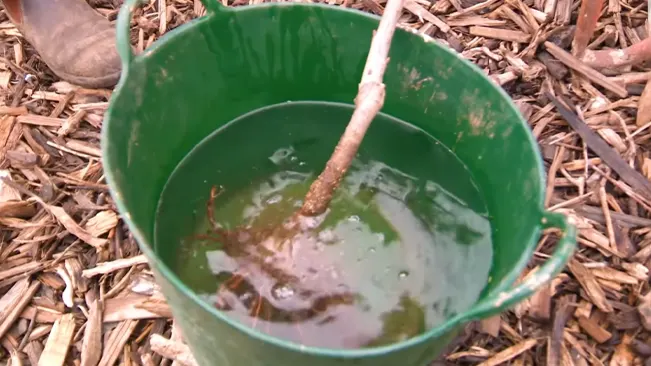
Soaking also helps the roots regain elasticity, allowing them to spread naturally in the soil, which promotes better establishment. However, avoid soaking the roots for more than 24 hours, as prolonged exposure to water can deprive them of oxygen and lead to root rot.
3. Choosing the Right Location
When selecting a planting site, ensure the location meets the tree’s specific needs. Consider factors such as sunlight, soil type, drainage, and proximity to other plants or structures. Most trees require at least 6 to 8 hours of direct sunlight daily, and the soil should be well-drained to prevent waterlogging.
Soil Quality
Perform a soil test to check for proper pH and nutrient levels. Most trees prefer slightly acidic to neutral soil (pH 6.0–7.0). You can amend the soil with compost or other organic matter to improve its quality if necessary.

4. Digging the Planting Hole
The planting hole should be wide enough to accommodate the tree’s root system and deep enough so that the roots can spread out naturally. A general rule of thumb is to dig a hole that is 2 to 3 times wider than the root spread but no deeper than the tree’s root crown (the area where the trunk meets the roots).
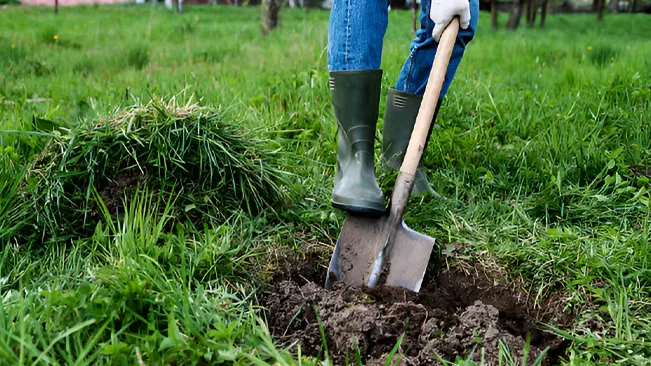
Planting the tree too deep can lead to root rot, while planting it too shallow may expose the roots to air and sunlight.
5. Planting the Bare Root Tree
Carefully place the tree into the hole, making sure the roots are spread out evenly. The root crown should be level with the ground surface. Fill in the hole with soil, gently packing it down to remove air pockets. Water the tree thoroughly after planting to help settle the soil around the roots.
Avoid Fertilizer
Do not add fertilizer to the planting hole. Fertilizer can burn the roots and delay the tree’s establishment. It’s better to wait until the tree is actively growing before applying any fertilizers.
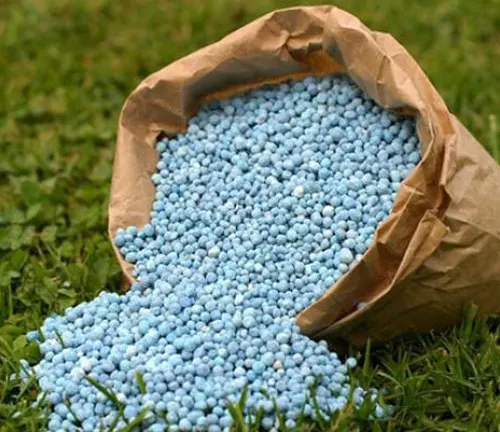
6. Mulching Around the Tree
Mulching is a critical step in helping bare root trees establish themselves by retaining moisture and regulating soil temperature around the root zone. Apply a 2-3 inch layer of mulch, such as wood chips or straw, evenly around the base of the tree, extending it out to the tree’s drip line to maximize coverage.

Be sure to keep the mulch a few inches away from the trunk itself to prevent moisture buildup, which can lead to rot, fungus, or pest infestations. In addition to moisture retention, mulch helps suppress weed growth, reducing competition for essential water and nutrients, ultimately giving the tree a better chance to thrive.
7. Watering Your Bare Root Tree
Proper watering is critical during the first few years of a tree’s life, especially for bare root trees. After planting, water the tree deeply to ensure the soil around the roots is fully saturated. Going forward, water the tree regularly, but be mindful not to overwater, as soggy soil can lead to root rot.
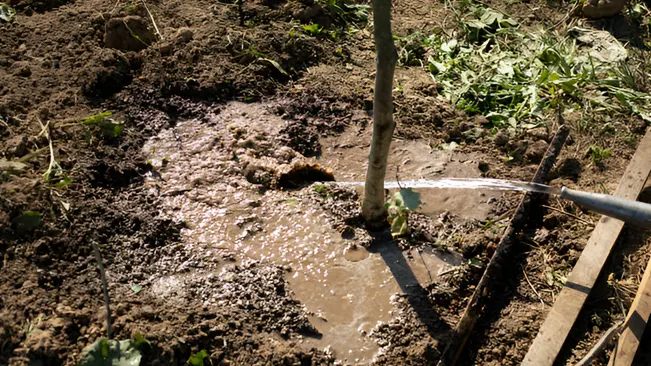
Watering Schedule:
- First Year: Water the tree every 1–2 weeks, depending on rainfall and soil conditions. During hot or dry periods, you may need to water more frequently.
- Second Year: Gradually reduce the frequency of watering as the tree becomes established. By the end of the second growing season, the tree should only need supplemental water during prolonged dry spells.
8. Staking the Tree (If Necessary)
Most bare root trees do not need staking, but if you’re planting in a windy area or if the tree has a weak trunk, staking may help stabilize it while the roots establish. Use flexible ties and place stakes loosely to avoid constricting the tree’s growth. Remove the stakes after the first year to allow the tree to grow naturally.
9. Pruning and Shaping
After planting, you may need to prune the tree to promote healthy growth. Pruning is especially important for fruit trees, as it encourages a strong structure that can support fruit production. Remove any damaged or broken branches, and prune back about one-third of the top growth to balance the tree’s root system with its foliage.
Ongoing Pruning: Continue to prune your tree annually in the late winter or early spring before new growth begins. Focus on removing dead, diseased, or crossing branches to promote good airflow and prevent disease.
10. Protecting Against Pests and Diseases
Bare root trees, like all trees, are susceptible to pests and diseases, especially during their early years. Protect your tree by regularly inspecting it for signs of trouble, such as discolored leaves, holes in the bark, or unusual growth patterns.
Preventive Measures:
- Tree Guards: Install a tree guard around the base to protect against animals like rabbits or deer that may chew on the bark.
- Organic Pesticides: Use organic or chemical pesticides as needed, but be cautious not to overapply, as this can harm beneficial insects and the environment.
- Fungicides: Apply fungicide treatments if your tree shows signs of fungal infections like powdery mildew or root rot.
Conclusion
Caring for bare root trees requires careful attention to detail, but with the right approach, these trees can thrive and become a beautiful part of your landscape. From proper planting and watering to ongoing care and protection, your bare root tree will reward you with years of beauty and, in the case of fruit trees, delicious harvests. Follow the steps outlined in this guide, and you’ll ensure the successful growth and longevity of your new tree.
Frequently Asked Questions (FAQ)
- What is the best time of year to plant bare root trees?
The best time to plant bare root trees is during their dormant period, typically from late fall to early spring. This gives them time to establish roots before the growing season begins. - How should I store bare root trees if I can’t plant them right away?
If you can’t plant your tree immediately, store it in a cool, shaded area with the roots wrapped in damp materials like burlap or newspaper to keep them moist. Plant within 1-2 days for the best results. - Do bare root trees need to be soaked before planting?
Yes, it’s recommended to soak the roots of bare root trees in water for 4 to 12 hours before planting. This helps hydrate the roots and gives them a better start in the ground. - How do I know if my bare root tree is planted at the right depth?
Ensure that the root crown (where the roots meet the trunk) is level with the soil surface. Planting the tree too deep can suffocate the roots, while planting too shallow can expose them to air and dry them out. - How often should I water a bare root tree after planting?
Water the tree immediately after planting, then continue watering every 1-2 weeks during the first growing season, depending on the weather. The goal is to keep the soil consistently moist but not waterlogged. - When should I start fertilizing my bare root tree?
Avoid fertilizing at the time of planting. You should wait until the tree has established and starts showing new growth, typically after its first growing season, before applying any fertilizer. - Can I plant bare root trees in clay or poor-draining soil?
Bare root trees can be planted in most soil types, but in clay or poorly drained soil, you’ll need to improve drainage by amending the soil with organic material like compost. Raised beds can also be a solution in areas prone to waterlogging. - How do I protect a newly planted bare root tree from pests?
Use tree guards to protect the trunk from animals like deer or rabbits. Additionally, regularly inspect the tree for signs of pests, and consider applying organic pesticides or fungicides if necessary. - How long does it take for a bare root tree to show signs of growth?
Most bare root trees will begin to show new growth in the first few weeks after planting, though it can sometimes take longer depending on the species and conditions. Look for new buds or green tissue under the bark to check for signs of life. - Do bare root trees need to be staked?
Most bare root trees don’t require staking unless planted in windy areas or if they have weak trunks. If you do stake the tree, use flexible ties and avoid constricting the trunk. Remove the stakes after one year to allow natural growth.

Emma Hudson
Forestry AuthorEmma's experience in farming shapes her detailed guides on gardening and farming tools, providing practical, actionable advice grounded in real-world experience. Her work targets both newcomers and experienced farmers, aiming to enhance their practices with a mix of traditional wisdom and modern techniques. By making complex agricultural concepts accessible, Emma's guides serve as valuable tools for those navigating the challenges of contemporary farming, offering strategies for sustainable success.







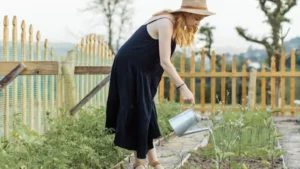
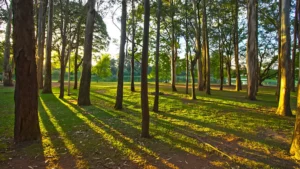




Leave your comment